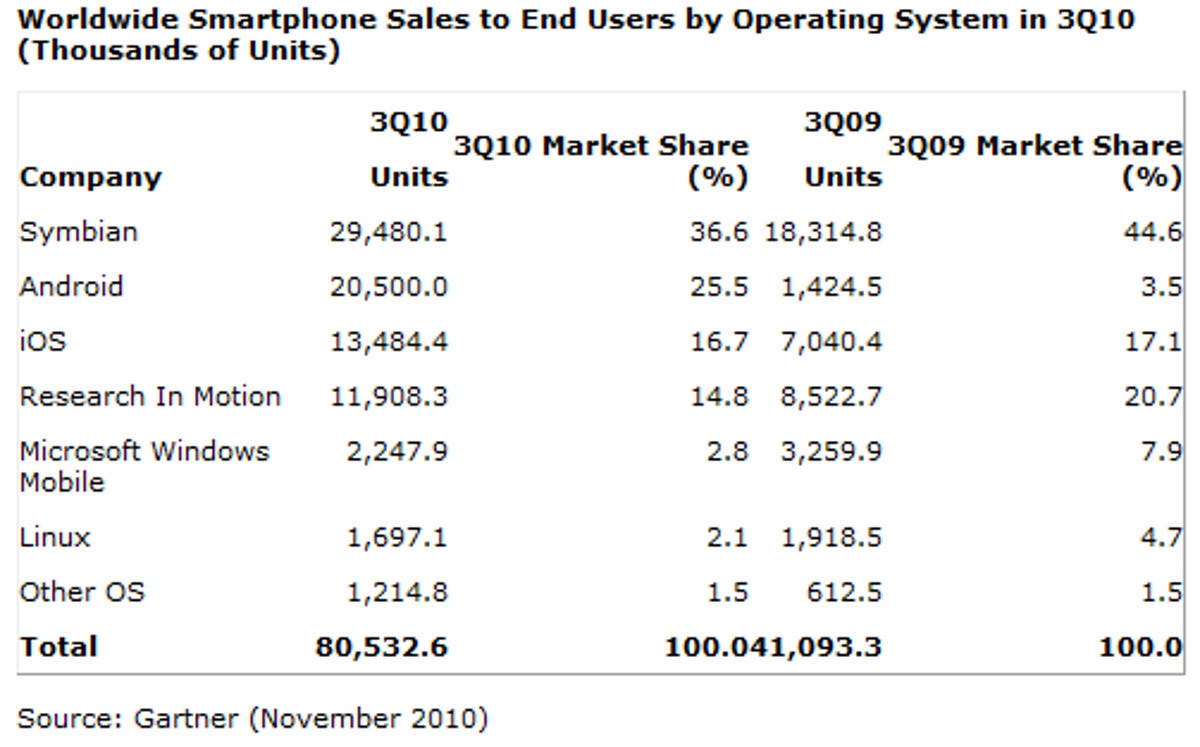Android captured the second-highest global market share of all smartphone operating systems in the third quarter, according to data released today by Gartner.
Driven by its year-long surge, Google’s mobile OS took home a 25.5 percent share of the global market, jumping from just 3.5 percent a year ago. Though still on top, Nokia’s Symbian continued to lose ground with a 36.6 chunk of the market, down from 44.6 percent in the year-ago quarter.

Gartner
Android phones have taken off in part because they can hit different consumer segments, says Gartner. Samsung has done well with high-end phones like the Galaxy S. But lower-priced models are also proving popular as evidenced by ZTE’s recent launch of a low-cost Android phone available in the U.K. as a prepaid package. Google is also trying to keep Android moving along by quickly releasing updates, with each one bringing in new features, some innovation, and a bit of polish to the operating system, according to Gartner.
Though Apple’s global smartphone market share dipped slightly in the third quarter to 16.7 percent from 17.1 percent, the company did well thanks to the debut of the iPhone 4. During the quarter, Apple’s share of the smartphone market shot past that of Research In Motion in North America. In Western Europe, iPhone sales doubled over the past year, helping to make Apple the third-largest vendor of overall mobile devices behind Nokia and Samsung.
“Apple’s dramatic expansion of iOS with the iPad and the continuing success of the iPod Touch are important sales achievements in their own right,” Carolina Milanesi, research vice president at Gartner, said in a statement. “But more importantly they contribute to the strength of Apple’s ecosystem and the iPhone in a way that smartphone-only manufacturers cannot compete with…While Android is increasingly available on media tablets and media players like the Galaxy Player, it lags far behind iOS’s multi-device presence.”
Looking at mobile phones in general, Nokia’s sales were a bit lower than expected due to a short supply of certain components. That affected the company’s overall mobile market share, but the shortages of lower-end phones actually prompted many consumers to buy more expensive devices, which helped Nokia’s quarterly financial results. Nokia sold 117.5 million handsets for the quarter.
Samsung enjoyed a strong quarter even though its mobile phone market share dropped a few percentage points. Mobile phone sales hit 71.7 million units, up 18.2 percent from last year’s third quarter. With its smartphone market share alone reaching 10 percent, Samsung sold 6.6 million Android phones, making it the top Android seller for the quarter.
For 2010 as a whole, Gartner expects the market for mobile phones and tablets to rise 30 percent from last year. Next year, tablets will have an impact on the sales of other mobile devices, as Gartner is forecasting that the iPad and rival tablets will sell 54.8 million units.



